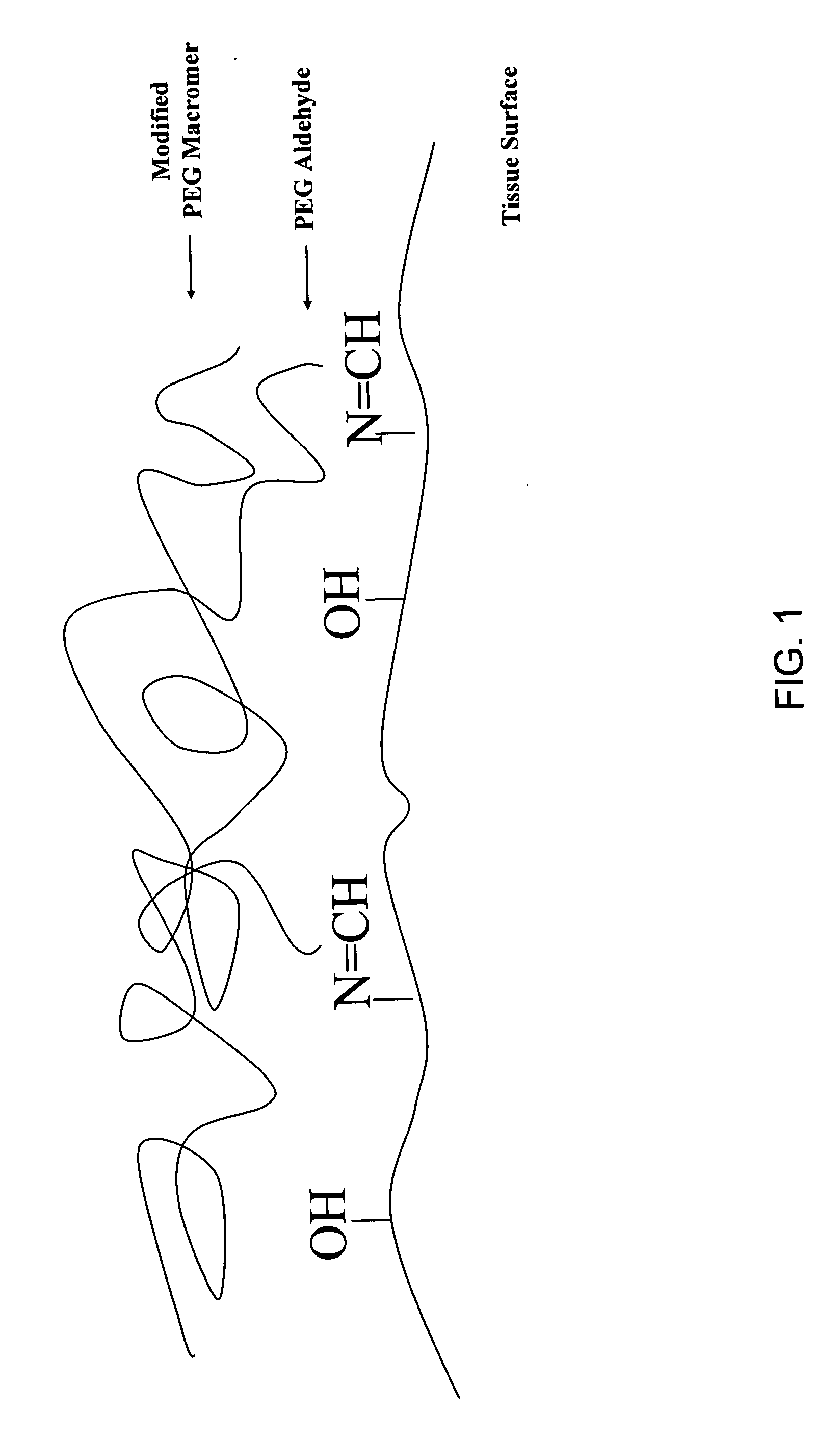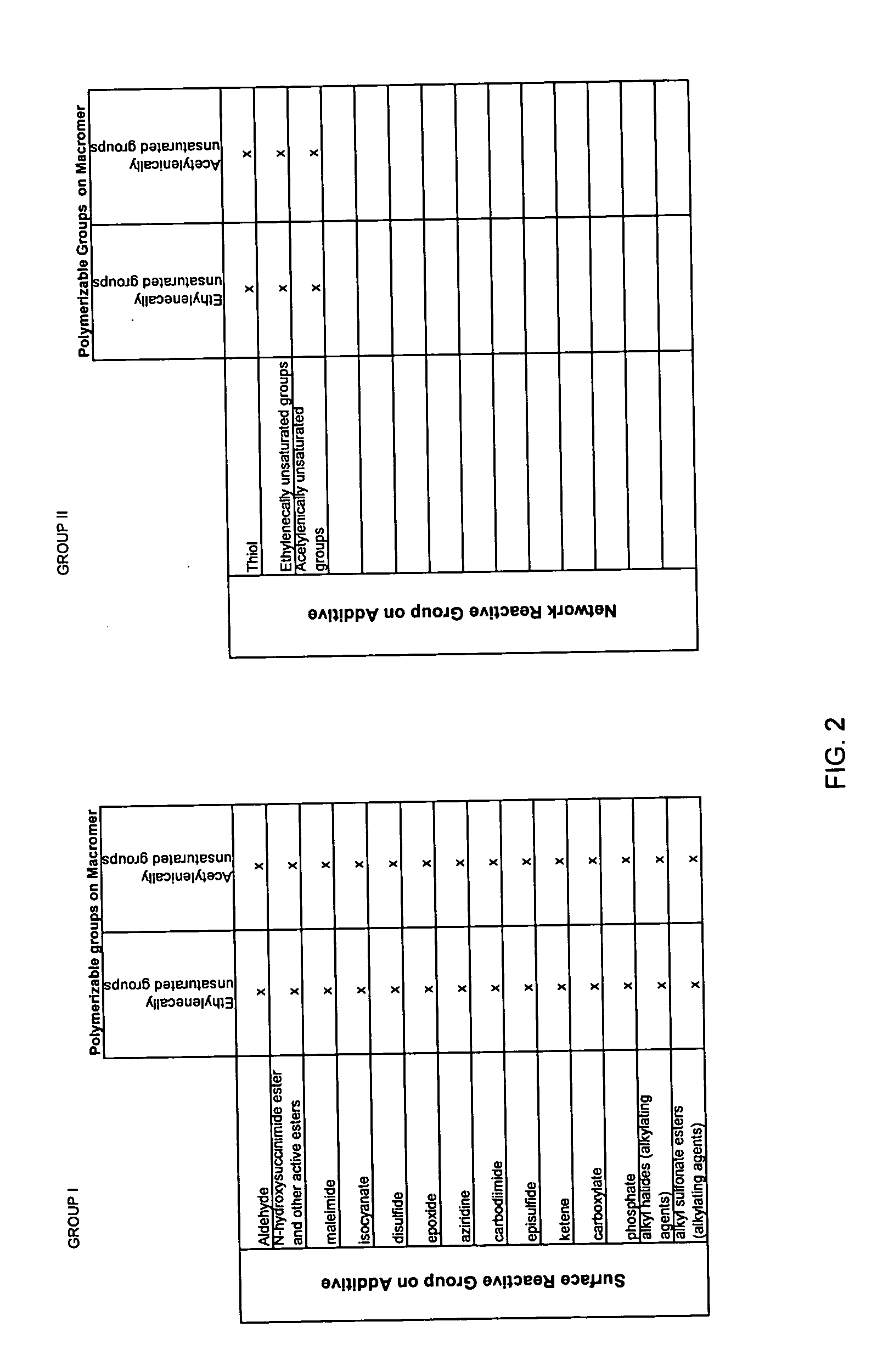Adherent polymeric compositions
a polymer composition and adhesion technology, applied in the field of adhesion polymer compositions, can solve the problems of difficult adhesion of the formed gel to the surface, difficult to achieve the effect of adhesion formation, and difficult to achieve adhesion formation
- Summary
- Abstract
- Description
- Claims
- Application Information
AI Technical Summary
Benefits of technology
Problems solved by technology
Method used
Image
Examples
example 1
[0116] Adherence of hydrogel formulations were scored using the pig myocardium model, in vivo beating heart (atria and ventricles). Lapse of time between the gel deposition and adherence scoring was 2 hours. The number of application sites per formulation was 2.
[0117] The experiment was conducted on two test groups: a control and treatment groups described below. The effect of PEG-dialdehyde as a tissue-reactive additive was evaluated by comparing the tissue adherence of a macromer solution (Solution 1) overlayed with a macromer overcoat or top layer (Overcoat 1) with a Solution 1 containing 10% 10 kDa PEG-dialdehyde (Solution 2) overlayed with Overcoat 1. Compositions of Solution 1, Solution 2 and Overcoat 1 are shown in Table A. Using an in vivo, beating pig heart model, Solution 1 and Solution 2 were brushed onto separate sites of the heart. Overcoat 1 was then mixed into each of the solution sites. Overcoat 1 was then applied in excess and both sites were then illuminated with ...
example 2
[0119] The effect of PEG-disuccinimidyl glutarate (Sun Bio West, Orinda, Calif.) was evaluated as a tissue-reactive additive by comparing gels prepared using Solution 1 and Overcoat 1 with gels prepared with Solution 1 containing 10% 8 kDa PEG-disuccinimidyl glutarate (Solution 3) and Overcoat 1. The composition of Solution 3 is detailed in Table B.
TABLE BComposition used to test PEG-disuccinimidyl glutarateas tissue-reactive additiveSolution 330% 3.3kL5A2 macromer3% sodium chloride2000 ppm eosin-Y0.5% ferrous gluconate1% fructose10% 8 kDa PEG-disuccinimidyl glutaratein water for injection
[0120] On separate sites on an in vivo, beating pig heart model, Solution 1 and Solution 3 were brushed into the myocardium. Over each of the solution sites, Overcoat 1 was mixed into the solution sites and then an excess of Overcoat 1 was then applied over the sites. Each of the gel sites was illuminated with visible light (100 mW / cm2, 40 seconds) to initiate photopolymerization. After 5 minutes...
example 3
[0121] The effect of PEG-disuccinimidyl glutarate as a tissue-reactive additive was evaluated by comparing the tissue adherence of a macromer solution (Solution 1) overlayed with an macromer overcoat (Overcoat 1) with Solution 3 overlayed with Overcoat 1. Using an in vivo, non-beating pig myocardium model, Solution 1 and Solution 3 were brushed onto separate sites of the heart. Overcoat 1 was then mixed into each of the solution sites. Overcoat 1 was then applied in excess and both sites were then illuminated with visible light (100 mW / cm2, 40 seconds) to initiate photopolymerization.
[0122] After 5 minutes, gels were scored for adherence using the 5-point scoring scale described above as shown in Table 3). Gels prepared with Solution 1 required light to moderate scraping to be removed from the tissue. Gels prepared with Solution 3 showed improved adherence over Solution 1 gels with repeated, vigorous scraping required to remove the gels from the myocardium.
TABLE 3Tissue adherence...
PUM
| Property | Measurement | Unit |
|---|---|---|
| molecular weight | aaaaa | aaaaa |
| molecular weight | aaaaa | aaaaa |
| molecular weight | aaaaa | aaaaa |
Abstract
Description
Claims
Application Information
 Login to View More
Login to View More - R&D
- Intellectual Property
- Life Sciences
- Materials
- Tech Scout
- Unparalleled Data Quality
- Higher Quality Content
- 60% Fewer Hallucinations
Browse by: Latest US Patents, China's latest patents, Technical Efficacy Thesaurus, Application Domain, Technology Topic, Popular Technical Reports.
© 2025 PatSnap. All rights reserved.Legal|Privacy policy|Modern Slavery Act Transparency Statement|Sitemap|About US| Contact US: help@patsnap.com


